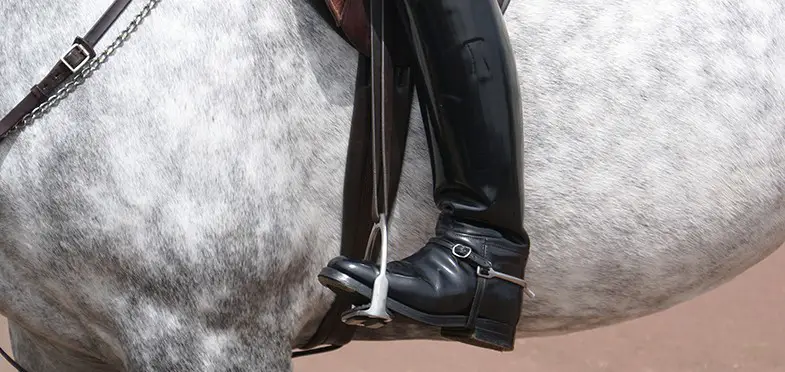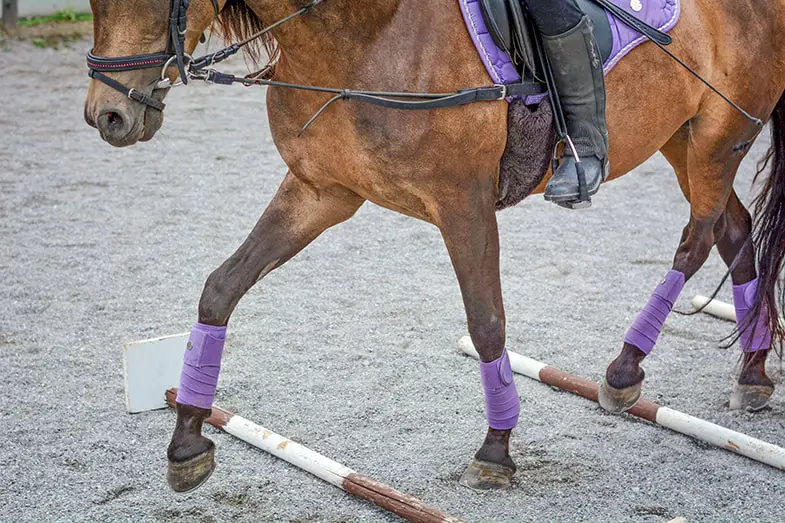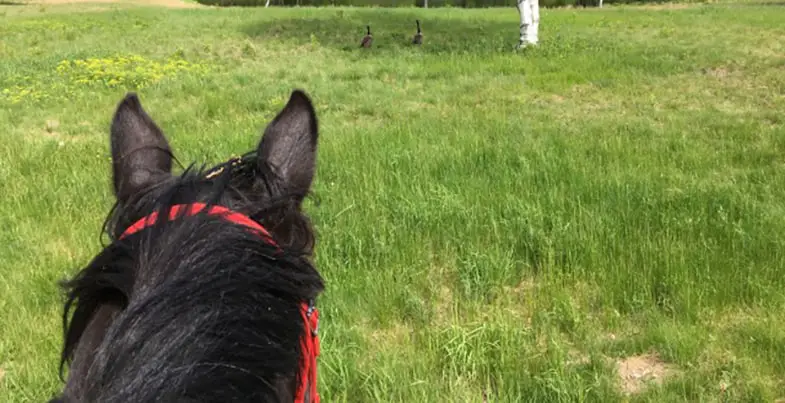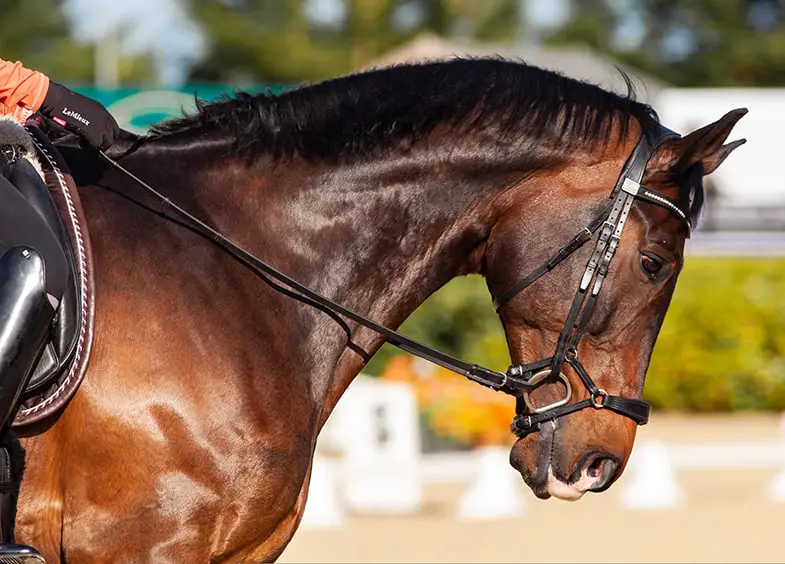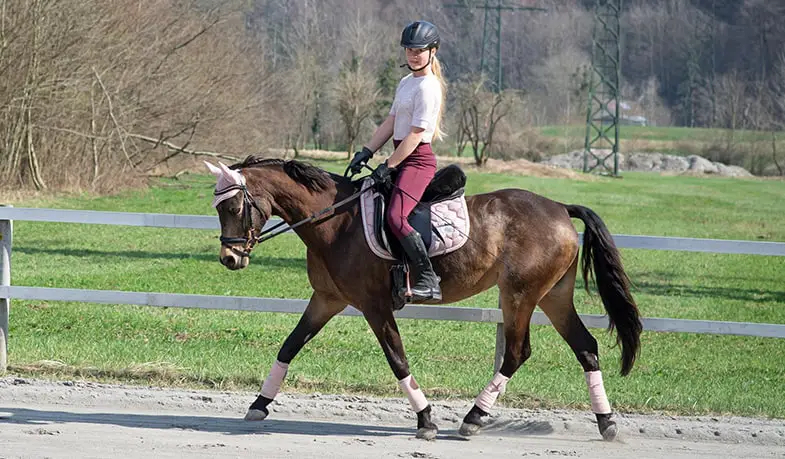Learning to horseback ride is a great thing but it can also seem like you have to learn a whole new language too. After all, where else in life would you hear phrases such as flying change and neck reining?
As a riding instructor myself I know that we’re guilty of using terminology that can be baffling to beginners which is why I decided to write this article. I wanted to explain the horseback riding lingo so that you’ll know exactly what your riding instructor is talking about when they ask you for more leg or tell you you’re posting on the wrong diagonal.
- Above the bit – If the horse is above the bit then their head is raised higher than the rider’s hands. This is normally caused by the rider holding the reins too tightly which applies too much pressure to the bit. Not only is it uncomfortable for the horse but it’ll reduce your control.
- Action – This is a general term used to describe the way that a horse moves but more commonly it’s used in reference to the way the horse uses its shoulder, humorous, elbow, and stifle when at gaits faster than a walk. It can also be used when talking about the high knee action of gaited horses.
- Aids – The ‘tools’ you use to communicate with the are referred to as aids but there are natural and artificial aids. Natural aids include your voice, legs, hands, and your body while artificial aids are things such as spurs and whips.
- Arena – When you first start learning to ride you’ll probably be riding in an enclosed area known as an arena. This can be either indoors or outdoors but it’ll mean that you don’t have to worry about the horse running away with you.
- Balk or balking – If the horse refuses to move or do what you’re asking them to do then your instructor may say that they’re balking.
- Bareback – Most of the time you’ll be riding with a saddle but if your instructor asks if you would like to ride bareback they’re asking if you want to ride without a saddle. Want to know more about riding bareback? The pros and cons of riding without a saddle.
- Bolting – While it probably won’t happen, if the horse runs away then it’s often referred to as bolting.
- Canter – A natural, three beat horse gait that sits between a trot and a gallop. It also involves a moment of suspension where all of the horse’s feet are off of the ground. A slow version of the canter is often performed in Western riding and is known as a lope. Want to know more about how to canter? Learn to ride a horse at a canter.
- Canter lead – When a horse canters they stretch one of their front legs further than the other which is referred to as the canter lead. For example, if the horse is on a left canter lead they’ll stretch further with their front left leg, likewise, if they stretch their right leg then they’re on a right canter lead.
- Cantle – If your instructor talks about the cantle they’re talking about the raised part at the back of the saddle.
- Carriage – The way a horse carries its head and neck is known as their carriage or the way they ‘carry’ themselves.
- Change diagonals – When you change direction your instructor will ask you to change diagonals too if you’re trotting. Don’t worry though this simply refers to the leg you’re posting (or rising) to when trotting and is easily done by sitting for two beats before rising again. If you’re riding in the open then you may be asked to do this from time to time anyway to stop the horse from tiring.
- Change rein – Changing rein just means you’re changing the direction you’re riding in which can be done in one of three ways. The first way is more common with Western riders and involves riding a small loop before doubling back on yourself and riding in the other direction. English riders tend to ride to the center of the arena before doubling back and riding in the opposite direction. The other way is more common when you’re trotting but involves riding from one corner of the arena to the other before turning to ride in the opposite direction.
- Collection or collected – This is more of a dressage term but it’s used to describe a pace (typically a canter) that’s been shortened but has the same rhythm.
- Counter canter – If your instructor asks you for a counter canter they’re asking you to canter on a curve with the outside leg leading instead of the inside leg. This is done to improve the horse’s suppleness and build muscle.
- Deep seat – If your instructor says you need to have a deep seat they’re telling you to place most of your weight on your seat bones and to use your weight to communicate with the horse. If you’re not sure how to sit on your seat bone just imagine you’re sitting on your back pockets and shift your weight to them. This will automatically move your weight to your seat bone.
- Diagonal – When a horse is trotting they move their legs diagonally with their right front and left rear moving together, followed by the left front and right rear.
- Disengage the rear end – When being asked to disengage the horse’s rear end you’re being asked to take the power and momentum out of their hindquarters. This can be used to stop the horse bucking, rearing, or bolting but is also done (in conjunction with engaging the rear end) to get the horse thinking about what they’re doing with their legs.
- Engage the rear end – As you’d expect this is the complete opposite of disengaging the rear and actually pushes the horse into its stride from behind.
- Equestrian – This is a general term used to describe anybody who takes part in horse-related activities such as owning, riding, and competing.
- Equitation – While it’s not widely used at riding schools, equitation is another way of saying horseback riding or horsemanship.
- Flying change or flying lead change – This is a move that’s performed, while cantering, to change the horse’s leading leg without changing the gait or the speed of the gait.
- Gait – The word gait simply refers to the movement and speed of the horse. All horses have the ability to walk, trot, canter, and gallop (as well as go backward) and these are known as natural gaits. Some horses can also perform other gaits, known as ambling gaits, that are occasionally (and wrongly) called artificial. If you want to know more about how horses move then check out my guide to understanding horse gaits.
- Gallop – The fastest of all natural gaits, the gallop is a four beat gait that, like the canter, has a moment where all four feet are off of the ground at the same time.
- Green – If your instructor describes you or the horse as being green don’t worry, they’re not saying you’re looking unwell. What they’re actually saying is that your or the horse is a beginner or are inexperienced. When it comes to horses they can also be referred to as green-broke.
- Getting the horse on contact – When you have the horse ‘on contact’ they’re respecting the pressure of the bit and listening to your commands. A sign of a horse being on contact is a rounding of the neck and then stretching into the bit. This is also a sign of good carriage.
- Groundwork – The basics of all horseback riding involves groundwork which refers to exercises that are done with or without a rider and involve the horse being asked to carry out certain tasks such as trotting over poles, backing around a corner, etc.
- Half halt – A half halt isn’t when the horse stops for a second and then carries on or when they almost come to a stop. Instead, it’s when the rider sits up and applies light pressure to both reins. This causes the horse to shift his weight to his rear end and therefore rebalance his weight.
- Halt – When your instructor tells you to halt they’re literally asking you to stop the horse by using your aids. Not sure how to stop a horse? Then check out my article that teaches you exactly how to stop a horse.
- Hand gallop – If your instructor asks you for a hand gallop don’t worry they’re not expecting you to get off and keep hold of the horse while they’re galloping. What they’re really asking for is a controlled version of the gallop.
- Heels down – This is one of the most common sayings you’ll hear your instructor saying (and certainly the one I say the most) and is exactly what it sounds like. Your instructor is telling you to point your toes up and your heels down toward the ground.
- Horn – When you first start learning to horseback ride your instructor may say you can hold onto the horn to help support yourself. If they do they’re talking about the front of a Western saddle which is known as a horn.
- Impulsion – When a horse moves forward using the power and drive of his hindquarters this is known as impulsion. It’s more commonly used in dressage but is still applicable to general horseback riding.
- Inside aids – When riding in an arena or enclosed space the inside aids refer to the hand and leg that are nearest the middle of the arena.
- Inside leg to outside rein – When your instructor asks for inside leg to outside rein they’re telling you to use your inside leg to move your horse’s middle towards the fence while moving forward with their shoulders being level with the contact of the outside rein. This encourages the horse to move properly (with their hindquarters being in line with the front) and bend correctly.
- Lead change – When the rider changes the leg the horse is leading on this is referred to as a lead change. While it can be done in the open it’s more commonly done by changing direction while riding in an arena.
- Lead or leading rein – The rein on the inside is known as the lead or leading rein.
- Leg up – If you’re not using a mounting block and are having trouble mounting the horse somebody will give you a ‘leg up’ by helping to literally lift your leg up. They do this by placing a hand under your bent knee and lifting you into the saddle.
- Light seat – The opposite of a deep seat, a light seat, which is sometimes referred to as a forward seat, means you lift your seat out of the saddle slightly and take your weight through your legs.
- Look between the horse’s ears – If your head is tipping forward or isn’t up straight you’ll be unbalancing both yourself and your horse which is why your instructor will tell you to look between the horse’s ears. They’re not necessarily telling you to look directly through their ears but more telling you to keep your head up and look where you’re going and where you want the horse to go.
- Lunge – A lunge is a type of rein that’s attached to the bridle and allows the horse to be controlled by somebody other than the rider. It’s normally used for beginners so that they can develop their balance without having to worry about controlling the horse.
- More leg – If your instructor asks you for more leg they want you to apply more pressure to the horse’s side with your legs.
- Mount/dismount – Getting on a horse is referred to as mounting and vice versa, getting off of a horse is known as dismounting.
- Near fore – When your instructor talks about the horse’s near fore, they’re talking about their left front leg.
- Nearside – While near fore is the front left leg of a horse, nearside refers to anything that happens on the left hand side, such as mounting on the nearside.
- Neck reining – In Western riding neck reining is where the rider holds the reins with one hand and uses the pressure of them (which is very light) on the horse’s neck to turn the horse. The horse has been trained to turn away from the side of the pressure.
- Off fore – As you can probably guess, if near fore means the horse’s left front leg, off fore is their right front leg.
- Offside – Likewise offside refers to the horse’s right side and anything that happens on the right hand side.
- On the bit – If a horse is on the bit they’re flexed at the poll and are moving forward well. They’re also more responsive to the rider’s aids.
- Open your chest – Some instructors will tell you to open your chest while others will say to sit up and put you’re shoulders back but they’re both talking about the same thing and that is the fact that you’re slouching in the saddle. The reason they’re telling you to sit up straight and put your shoulders back is because you’re less balanced if you don’t. Want to sit better in the saddle? Then head over to my article on improving your posture in the saddle.
- Outside aids – If you’re riding in an enclosed area then the outside aids are the hand and leg that are closest to the fence or rail of the arena.
- Pommel – While the front of a Western saddle is known as a horn, the front of an English saddle is called a pommel.
- Posting – Sometimes called rising, this is when the rider rises out of the saddle and sits back as the horse trots. It prevents bouncing on the horse’s back and makes it more comfortable for both of you.
- Quarters – Quarters is a shortened version of hindquarters which refers to the rear end of the horse, but is more generally used when talking about the horse’s hind legs.
- Quiet leg – If your instructor tells you you’re riding with a quiet leg it’s a good thing. This means that your legs stay still and only squeeze the horse’s sides when needed. The opposite of a quiet leg is sometimes called a loud leg, but it’s not good.
- Rein back – Sometimes called back up, it simply refers to the horse moving backward on command, typically in Western or dressage.
- Rein in – Some instructors will ask you to rein in which means to gently pull the reins to stop the horse.
- Ride the inside track – When riding in an arena your instructor may ask you to ride the inside track which means you need to ride around five feet away from the fence. This means that you can’t use the fence to keep the horse straight which makes it harder, but it’s an exercise that’s designed to help you use your legs, seat, and reins to keep the horse going straight.
- Simple change – When a horse changes its leading leg while cantering by changing gait or slowing down before cantering again it’s called a simple change.
- Soft hands – Like a quiet leg, soft hands mean that your hands are still and aren’t pulling or gripping on the reins. It also means that your hands are soft, supple, and forgiving when controlling the horse.
- Topline – The area of the horse’s back that runs from the poll (in between the ears) to the dock (the base of the tail) is known as the topline. Want to know how to improve your horse’s topline? Head over to my recent article on strengthening your horse’s back.
- Transition – Any change between gaits is known as a transition.
- Trot – A diagonal gait that’s faster than a walk. When trotting the horse’s legs will move in a diagonal motion with the left front and right rear moving together and vice versa for the other legs. Some people refer to the trot as a jog but this isn’t quite the same, a jog is a much slower trot that’s performed by Western riders. Are you learning to ride? Why not check out my article on how to ride a horse at a trot?
- Three-point – A normal riding position is known as three-point because you have three points of contact with the horse, your seat, right leg, and left leg.
- Turn on the forehand – The horse pivots its body around its front legs by moving the back legs while the front ones stay still.
- Turn on the haunches – Like turning on the forehand, turning on the haunches has the horse pivoting around but this time the front legs pivot around the hind ones.
- Two-point – Sometimes referred to as the jumping position, two-point is the two points of contact you have with the horse (or more precisely the saddle) when you’re jumping or galloping. It’s called that because instead of being in contact with the saddle with your legs and your seat you’re actually raised out of the saddle slightly so only your legs are in contact.
- Wrong diagonal – If your instructor says you’re on the wrong diagonal they’re telling you that you’re posting (or rising) when the horse’s outside leg hits the ground instead of when the leg leaves the ground. This is easy to correct though by sitting for two beats before rising again. If you want to know more about diagonals then you should check out my article all about understanding your diagonals.
I hope you found this article helpful. If you did I’d be grateful if you could share it please as it would really help me.
Recommended products
Over the years I have tried hundreds of different horsey products, from various blankets and halters to different treats. Some I’ve loved, others I’ve hated but I thought I’d share with you my top all-time favorite products, the ones I never leave the yard without. I’ve included links to the products (which are in no particular order) that I really think are great.
- Horse Knots by Reference Ready – If you’re like me and enjoy pocket reference guides then you’ll love this knot tying guide. These handy cards can easily fit in your pocket or attach to the saddle for quick reference. They’re waterproof, durable and are color coded to make them easy to follow.
- Mane ’n Tail Detangler – Even if you never show your horse you’ll need to detangle his tail from time to time (and possibly his mane too) which is always a challenging chore! I’ve found that if I run a little bit of detangler through my horse’s tails every few days it stops them from getting matted up and makes combing them easy, even if they’re coated in mud. I don’t know if I should admit to this or not but it also works wonders on my hair.
- TAKEKIT Pro clippers – Over the years I’ve tried a lot of different clippers and while some were obviously better than others I found these to be by far the best. They are heavier than a lot of other clippers but for me, that’s a good thing, it makes them feel more sturdy and hardwearing. On top of that they have a range of speeds so are just as good for clipping your horse’s back as they are his face. I also like the fact that they come in a handy carry case but that’s not for everybody. The company that makes them is super good and incredibly helpful too, a real bonus these days. The only thing I wasn’t keen on was the fact that it doesn’t come with any oil, but that’s not a major problem as it’s not difficult to buy lubricant.
- Shire’s ball feeder – There are so many boredom buster toys out there but I like to use these every day, regardless of whether or not my horses are bored. I find that it helps to encourage my horses to problem solve by rewarding them with treats (or pieces of fruit) but it also mimics their natural grazing behavior which helps to keep them calm and de-stressed.
- Horse safe mirror – This is a strange one that many people are surprised about but I like to put horse safe mirrors in the trailers as well as in the quarantine stalls. It helps to prevent the feeling of isolation by giving the impression of other horses being around. Being herd animals horses can get extremely stressed when they feel that they’re on their own but with these stick-on mirrors, they believe that at least one other horse is with them.
- Rectal thermometer – I know this isn’t glamourous at all but it’s vital for your horse’s well-being to be able to check their temperature and a rectal thermometer is the easiest way of doing this which is why I’ve added it to the list.
Shopping lists
I’ve also put together a few shopping lists of essential items that I’ve found helpful over the years. I’ve broken the lists down into different categories rather than put everything in one massive list 😉

